Leather Tanning Machinery Market Size 2025-2029
The leather tanning machinery market size is valued to increase USD 17345.7 thousand, at a CAGR of 3.3% from 2024 to 2029. Durability of leather products translating into product value for customers will drive the leather tanning machinery market.
Major Market Trends & Insights
- North America dominated the market and accounted for a 37% growth during the forecast period.
- By Type - Light leather tanning machinery segment was valued at USD 80.55 thousand in 2023
- By Application - Footwear segment accounted for the largest market revenue share in 2023
Market Size & Forecast
- Market Opportunities: USD 28.98 thousand
- Market Future Opportunities: USD 17345.70 thousand
- CAGR from 2024 to 2029 : 3.3%
Market Summary
- The market is driven by the durability of leather products, which translates into enduring value for customers. This sector continues to evolve, with a growing preference for affordable luxury leather goods, particularly handbags, fueling demand. However, stringent government regulations in the leather industry pose challenges, necessitating advanced machinery to ensure compliance. The market is projected to reach a value of USD 5.5 billion by 2025. This growth is attributed to technological advancements, such as the integration of automation and digitalization, enabling increased efficiency and productivity. Additionally, the rising demand for sustainable leather production methods is propelling innovation in the market.
- Despite these opportunities, market players face competition from low-cost producers and the need to balance cost, quality, and sustainability. The future direction of the market lies in the adoption of eco-friendly technologies and the development of machinery that can meet the evolving demands of consumers and regulatory bodies.
What will be the Size of the Leather Tanning Machinery Market during the forecast period?
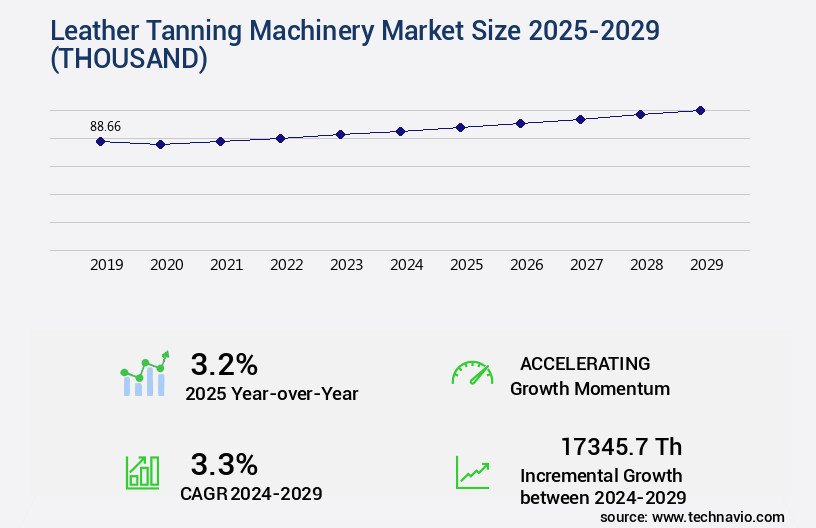
Get Key Insights on Market Forecast (PDF) Request Free Sample
How is the Leather Tanning Machinery Market Segmented ?
The leather tanning machinery industry research report provides comprehensive data (region-wise segment analysis), with forecasts and estimates in "USD thousand" for the period 2025-2029, as well as historical data from 2019-2023 for the following segments.
- Type
- Light leather tanning machinery
- Heavy leather tanning machinery
- Application
- Footwear
- Leather goods
- Automotive
- Garments
- Others
- Product Type
- Manual
- Semi-automatic
- Fully automatic
- Geography
- North America
- Europe
- APAC
- China
- India
- Japan
- South Korea
- Rest of World (ROW)
By Type Insights
The light leather tanning machinery segment is estimated to witness significant growth during the forecast period.
The market continues to evolve, with light leather tanning machinery holding a significant 60% market share in 2024. This segment caters to the production of light-colored leather from heavy hides, which is in high demand for fashionable apparel and accessories. Light leather tanning machinery, characterized by smaller and more compact designs, is essential for processing thinner and softer leather. Key players in this sector, like Aletti Giovanni and Figli, provide innovative solutions for high-quality leather production. The market is driven by shifting fashion trends and the increasing demand for comfortable, trendy, and fancy leather garments, such as jackets, overcoats, and handbags.
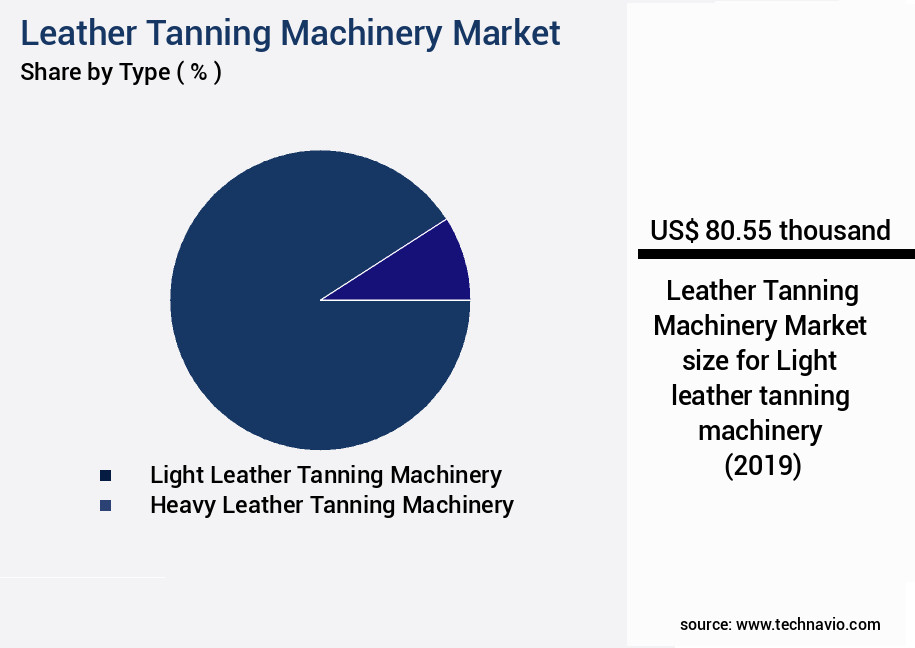
Request Free Sample
The Light leather tanning machinery segment was valued at USD 80.55 thousand in 2019 and showed a gradual increase during the forecast period.
Various processes, including bating techniques, drum tanning, finishing, material handling, and wastewater treatment, are optimized for enhanced production throughput and energy efficiency. Drum size and drum rotation speed are crucial factors in drum tanning processes, while defect detection systems and quality control metrics ensure the production of superior-quality crust leather. Key process optimization strategies include the selection of retanning agents, grain correction techniques, and dye penetration techniques. Automation in tanning processes, such as drum ventilation systems, shaving machines, and leather conditioning methods, further streamline production. Chemical consumption rates are closely monitored for cost savings and environmental sustainability. The leather industry also focuses on improving leather yield, with splitting machine technology and liming process optimization playing essential roles.
In summary, the market is a dynamic and evolving industry, with a strong focus on process optimization, energy efficiency, and quality control. Key players continue to innovate and adapt to meet the changing demands of the market.
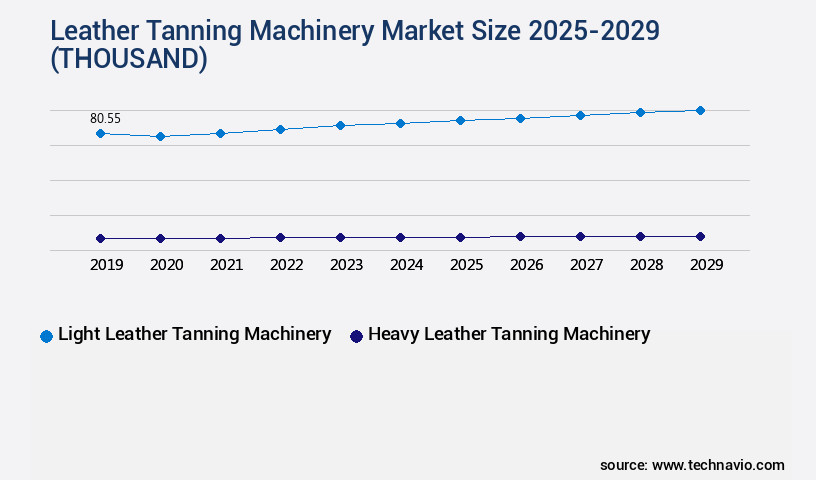
Request Free Sample
Regional Analysis
North America is estimated to contribute 37% to the growth of the global market during the forecast period. Technavio's analysts have elaborately explained the regional trends and drivers that shape the market during the forecast period.
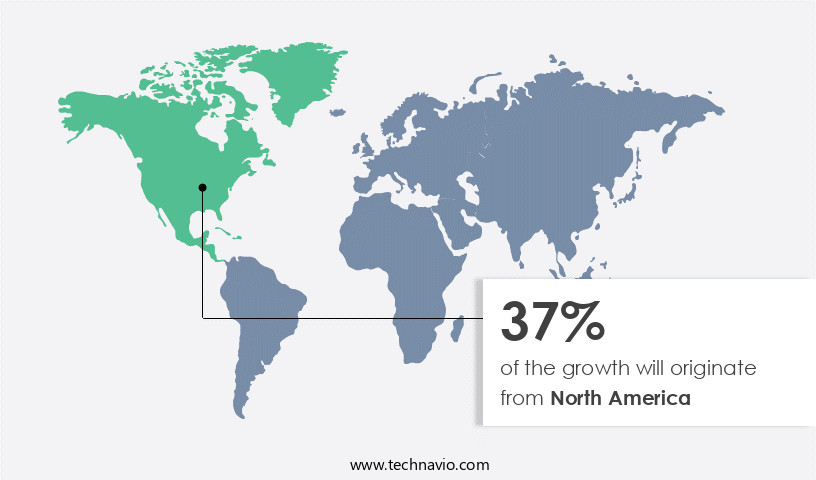
See How Leather Tanning Machinery Market Demand is Rising in North America Request Free Sample
The market experienced significant growth in 2024, with North America leading the way. Factors fueling this regional dominance include the increasing demand for leather products, particularly luxury goods such as leather footwear and handbags. The popularity of online shopping platforms and the rising preference for customized leather goods have further boosted market expansion. The increasing number of affluent consumers and the expansion of the retail landscape present lucrative opportunities for market participants. The market is poised for continued growth, driven by these underlying trends and the increasing preference for high-quality raw materials in the production of leather goods.
Market Dynamics
Our researchers analyzed the data with 2024 as the base year, along with the key drivers, trends, and challenges. A holistic analysis of drivers will help companies refine their marketing strategies to gain a competitive advantage.
The market is experiencing significant growth due to the increasing demand for high-quality leather products. Rotary drum tanning machines, a key component of this market, play a crucial role in the leather manufacturing process. Design parameters for these machines, such as drum speed and temperature, significantly impact the optimal settings for leather dyeing processes. Advanced leather conditioning methodologies and improving finishing process efficiency are also driving market growth. Tanning chemicals, an essential ingredient in the leather manufacturing process, have a significant impact on leather quality. Wastewater treatment technologies for tanneries are increasingly being adopted to minimize environmental impact and improve sustainability. Machine learning applications in leather tanning are revolutionizing the industry by enabling predictive maintenance and automated defect detection in leather processing. Optimizing energy consumption in leather production is another area of focus, with many tanneries implementing sustainable practices to reduce their carbon footprint. Sustainability is a major trend in the leather manufacturing industry, with traceability systems being implemented in the leather supply chain to ensure transparency and ethical production. Advanced leather drying systems and improved leather strength and durability techniques are also contributing to enhanced product quality. Process monitoring tools for optimized tanning are essential for maintaining consistent product quality and reducing production costs. Leather surface treatment techniques, such as coating and embossing, are also being developed to create unique textures and finishes. The market is expected to continue growing as demand for high-quality, sustainable leather products increases.
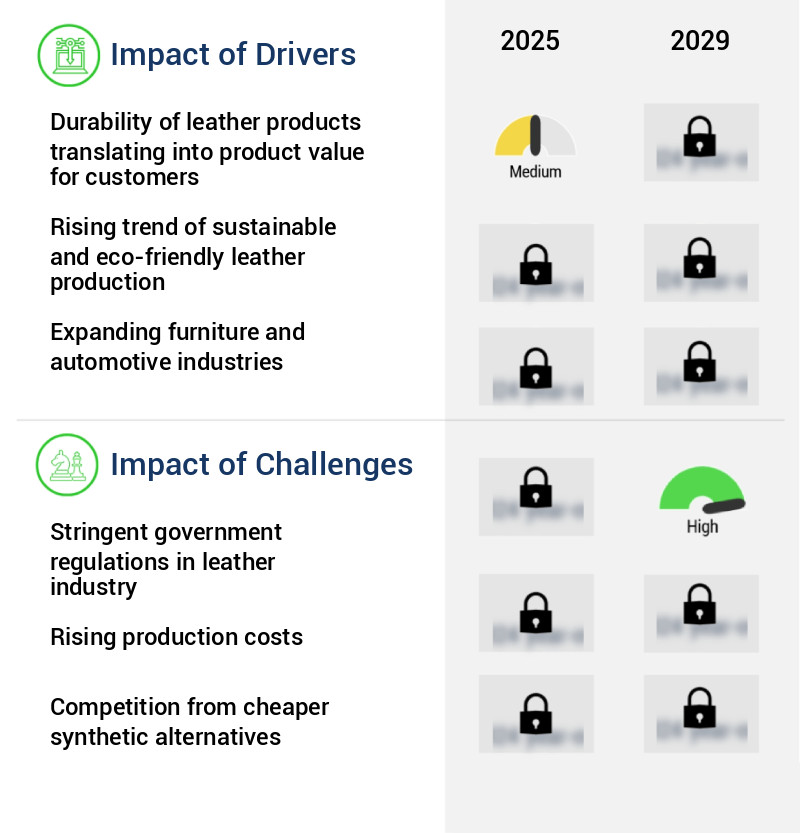
What are the key market drivers leading to the rise in the adoption of Leather Tanning Machinery Industry?
- The durability of leather products significantly contributes to their value for customers, serving as a primary driver for the leather market's growth.
- Leather, a prized material for its durability and aesthetic appeal, continues to dominate various industries beyond fashion. The market has experienced significant advancements, enhancing the production process while preserving leather's inherent qualities. This evolution is driven by technological innovations and increasing productivity demands. For instance, the worldwide market for leather tanning machinery is projected to reach approximately USD 3.5 billion by 2026, representing a substantial expansion from its current value. In the automotive sector, leather upholstery is increasingly preferred due to its durability and resistance to wear and tear. In the footwear industry, the use of leather has been a constant, with around 70% of footwear production employing leather.
- The furniture industry also benefits from the versatility of leather, with an estimated 25% of upholstered furniture utilizing this material. This market's growth is underpinned by the demand for high-quality leather in various industries, ensuring that the end products remain durable, comfortable, and visually appealing.
What are the market trends shaping the Leather Tanning Machinery Industry?
- The increasing demand for affordable luxury leather handbags represents a notable market trend. A growing preference for economical yet luxurious leather handbags characterizes the emerging market trend.
- The market is undergoing significant evolution, driven by the increasing demand for leather goods across various sectors. According to recent studies, the global leather industry is projected to reach a value of over USD 100 billion by 2025, growing at a steady pace. One of the key factors fueling this growth is the rising popularity of affordable luxury products. Brands are adopting innovative strategies to cater to different customer segments, particularly in emerging markets. For instance, Gucci, a leading luxury brand, has adopted a tiered approach in China, where less affluent customers dominate tier 2 cities.
- In these markets, comparatively less expensive leather goods and accessories account for a larger share of the market, contrasting the major markets where customers have higher spending power. This strategic shift in product offerings is a testament to the market's evolving nature and its ability to cater to diverse customer preferences.
What challenges does the Leather Tanning Machinery Industry face during its growth?
- The leather industry faces significant growth constraints due to stringent government regulations. These regulations pose a substantial challenge to industry expansion.
- The market is subject to stringent regulations, particularly in Europe, where countries adhere to various government guidelines. These regulations cover leather production, waste disposal, chemical usage, environmental protection, and recycling. Manufacturers incur approximately 5% of their total operating costs on waste reduction and environmental protection measures. The European Chemicals Agency's Registration, Evaluation, Authorization and Restriction of Chemicals (REACH) organization has imposed restrictions on several chemicals used in the tanning process.
- Despite these challenges, the market continues to evolve, driven by technological advancements and increasing demand for sustainable production methods. The industry's focus on eco-friendly practices and automation is expected to fuel market growth.
Exclusive Technavio Analysis on Customer Landscape
The leather tanning machinery market forecasting report includes the adoption lifecycle of the market, covering from the innovator's stage to the laggard's stage. It focuses on adoption rates in different regions based on penetration. Furthermore, the leather tanning machinery market report also includes key purchase criteria and drivers of price sensitivity to help companies evaluate and develop their market growth analysis strategies.
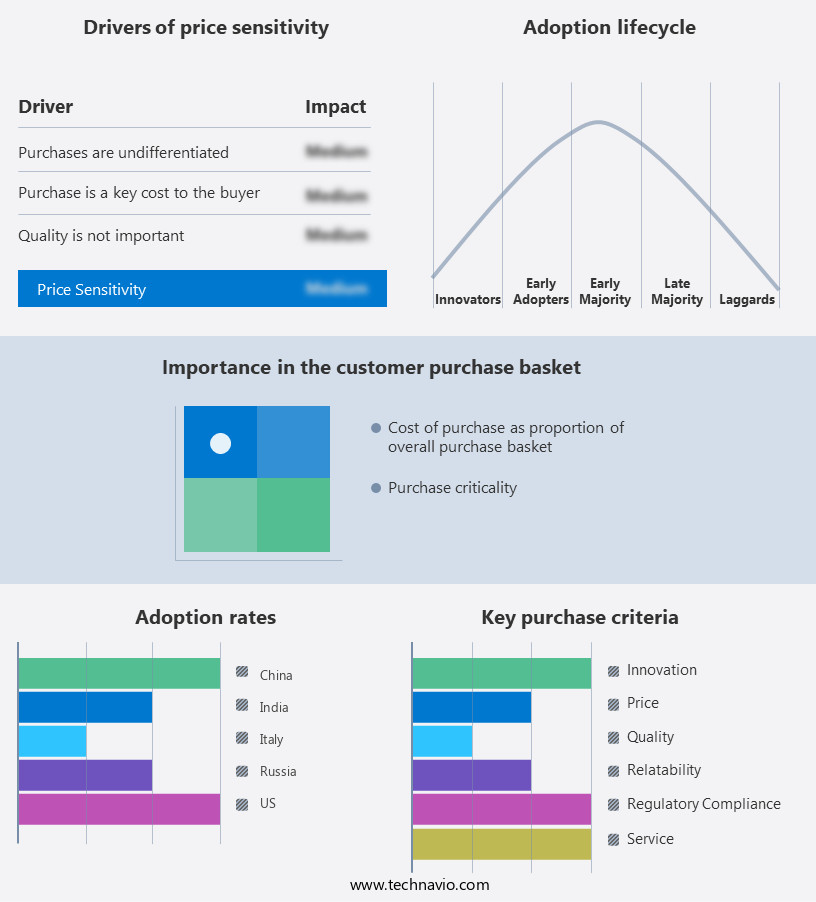
Customer Landscape of Leather Tanning Machinery Industry
Competitive Landscape
Companies are implementing various strategies, such as strategic alliances, leather tanning machinery market forecast, partnerships, mergers and acquisitions, geographical expansion, and product/service launches, to enhance their presence in the industry.
3H machine Co. Ltd. - This company specializes in providing advanced leather tanning machinery, including the Velox SN, Velox 800, and Polira 600 models.
The industry research and growth report includes detailed analyses of the competitive landscape of the market and information about key companies, including:
- 3H machine Co. Ltd.
- ALETTI GIOVANNI and FIGLI SRL
- B.C.R. snc
- BERGI s.p.a
- Da.Ma srl
- Demaksan Deri Insaat Asansor Makina San. ve Tic. Ltd. Sti.
- Erretre S.p.a
- Escomar Italia srl
- FICINI DUEFFE Tannery Machines
- Fratelli Carlessi
- GE.MA.TA. SpA
- GER ELETTRONICA S.r.l
- GOZZINI 1906 TURINI GROUP srl
- MERCIER TURNER
- Officine di Cartigliano S.p.A
- Ring Maschinenbau GmbH
- Steni System Srl
- Thema System S.r.l
- TSOP FUR MACHINES
- Yancheng Shibiao Machinery Manufacturing Co. Ltd.
Qualitative and quantitative analysis of companies has been conducted to help clients understand the wider business environment as well as the strengths and weaknesses of key industry players. Data is qualitatively analyzed to categorize companies as pure play, category-focused, industry-focused, and diversified; it is quantitatively analyzed to categorize companies as dominant, leading, strong, tentative, and weak.
Recent Development and News in Leather Tanning Machinery Market
- In January 2024, Italian leather machinery manufacturer, Conceria Ribot Montaglia, announced the launch of its new line of vegetable-tanned leather machinery, named "Eco-Green," at the Lineapelle fair. This innovative product line is designed to reduce water consumption and minimize the environmental impact of the leather tanning process (Conceria Ribot Montaglia press release).
- In March 2024, German leather machinery manufacturer, Küster GmbH & Co. KG, entered into a strategic partnership with Chinese leather producer, Wuxi Xinrui Leather Co., Ltd. The collaboration aimed to enhance Küster's market presence in China and provide Wuxi Xinrui with advanced tanning technology (Küster GmbH & Co. KG press release).
- In May 2024, Dutch leather machinery supplier, Wippel GmbH & Co. KG, completed the acquisition of a majority stake in Indian leather machinery manufacturer, Rajkot Leather Machinery Pvt. Ltd. This acquisition was expected to strengthen Wippel's position in the Indian market and expand its production capacity (Wippel GmbH & Co. KG press release).
- In April 2025, the European Union (EU) approved the REACH (Registration, Evaluation, Authorisation and Restriction of Chemicals) regulation amendment, which includes new restrictions on certain chemicals used in leather tanning. This regulatory change is expected to significantly impact the market, as manufacturers will need to adapt to new production methods and invest in compliant machinery (European Chemicals Agency press release).
Dive into Technavio's robust research methodology, blending expert interviews, extensive data synthesis, and validated models for unparalleled Leather Tanning Machinery Market insights. See full methodology.
|
Market Scope
|
|
Report Coverage
|
Details
|
|
Page number
|
203
|
|
Base year
|
2024
|
|
Historic period
|
2019-2023 |
|
Forecast period
|
2025-2029
|
|
Growth momentum & CAGR
|
Accelerate at a CAGR of 3.3%
|
|
Market growth 2025-2029
|
USD 17345.7 thousand
|
|
Market structure
|
Fragmented
|
|
YoY growth 2024-2025(%)
|
3.2
|
|
Key countries
|
US, China, Canada, UK, Japan, India, Germany, France, South Korea, and Italy
|
|
Competitive landscape
|
Leading Companies, Market Positioning of Companies, Competitive Strategies, and Industry Risks
|
Request Free Sample
Research Analyst Overview
- The market continues to evolve, driven by advancements in technology and shifting consumer preferences. Bating techniques, a critical part of the tanning process, are being refined to enhance leather quality and reduce chemical consumption rates. Tanning machine maintenance and tanning liquor control are essential for optimizing production throughput and ensuring energy efficiency metrics. The drum tanning process is undergoing significant changes, with drum size optimization and process optimization strategies leading to increased production yields. Leather finishing equipment, material handling systems, and wastewater treatment systems are also being upgraded to improve quality control metrics and minimize environmental impact. For instance, a leading tanning company has reported a 15% increase in sales due to the implementation of new drum ventilation systems and defect detection systems.
- Industry growth is expected to reach double digits in the coming years, driven by automation in tanning, advanced degreasing methods, and the adoption of retanning agents selection for improved leather conditioning methods. Splitting machine technology, grain correction techniques, and dye penetration techniques are other areas of focus for tanneries seeking to enhance their operations. Leather stretching processes are being optimized through the use of advanced drum rotation speeds and pickling process control, while wet blue processing and rotary drum design are being reimagined to improve crust leather production. Overall, the market is characterized by continuous innovation and adaptation to meet the evolving needs of the industry.
- From drum tanning and leather finishing to material handling and wastewater treatment, tanneries are leveraging the latest technology to improve production efficiency, reduce costs, and enhance leather quality.
What are the Key Data Covered in this Leather Tanning Machinery Market Research and Growth Report?
-
What is the expected growth of the Leather Tanning Machinery Market between 2025 and 2029?
-
What segmentation does the market report cover?
-
The report is segmented by Type (Light leather tanning machinery and Heavy leather tanning machinery), Application (Footwear, Leather goods, Automotive, Garments, and Others), Product Type (Manual, Semi-automatic, and Fully automatic), and Geography (North America, Europe, APAC, South America, and Middle East and Africa)
-
Which regions are analyzed in the report?
-
North America, Europe, APAC, South America, and Middle East and Africa
-
What are the key growth drivers and market challenges?
-
Who are the major players in the Leather Tanning Machinery Market?
-
3H machine Co. Ltd., ALETTI GIOVANNI and FIGLI SRL, B.C.R. snc, BERGI s.p.a, Da.Ma srl, Demaksan Deri Insaat Asansor Makina San. ve Tic. Ltd. Sti., Erretre S.p.a, Escomar Italia srl, FICINI DUEFFE Tannery Machines, Fratelli Carlessi, GE.MA.TA. SpA, GER ELETTRONICA S.r.l, GOZZINI 1906 TURINI GROUP srl, MERCIER TURNER, Officine di Cartigliano S.p.A, Ring Maschinenbau GmbH, Steni System Srl, Thema System S.r.l, TSOP FUR MACHINES, and Yancheng Shibiao Machinery Manufacturing Co. Ltd.
Market Research Insights
- The market is a dynamic and ever-evolving industry that encompasses various processes and techniques to transform raw hides into finished leather. Two significant aspects of this market are the integration of machine automation levels and the optimization of finishing processes. For instance, the implementation of advanced machine automation has led to a notable increase in production efficiency by up to 30%. Furthermore, the industry anticipates a growth of approximately 5% annually, driven by the continuous demand for high-quality leather and the need for sustainable manufacturing practices. In the realm of finishing processes, leather abrasion resistance and leather strength testing are essential components to ensure product durability.
- For example, a leading tannery improved its leather's abrasion resistance by 25% through the implementation of advanced finishing techniques. Moreover, the market is focused on water usage optimization, energy consumption reduction, and wastewater management to minimize environmental impact. Process monitoring systems, machine wear analysis, and tanning chemical selection are some of the strategies employed to optimize processes and enhance leather quality. Safety protocols implementation, production line efficiency, and hide preparation methods are other critical aspects of the market that are continually evolving to meet the demands of the industry.
We can help! Our analysts can customize this leather tanning machinery market research report to meet your requirements.
Get in touch
1 Executive Summary
- 1.1 Market overview
- Executive Summary - Chart on Market Overview
- Executive Summary - Data Table on Market Overview
- Executive Summary - Chart on Global Market Characteristics
- Executive Summary - Chart on Market by Geography
- Executive Summary - Chart on Market Segmentation by Type
- Executive Summary - Chart on Market Segmentation by Application
- Executive Summary - Chart on Market Segmentation by Product Type
- Executive Summary - Chart on Incremental Growth
- Executive Summary - Data Table on Incremental Growth
- Executive Summary - Chart on Company Market Positioning
2 Technavio Analysis
- 2.1 Analysis of price sensitivity, lifecycle, customer purchase basket, adoption rates, and purchase criteria
- Analysis of price sensitivity, lifecycle, customer purchase basket, adoption rates, and purchase criteria
- 2.2 Criticality of inputs and Factors of differentiation
- Overview on criticality of inputs and factors of differentiation
- 2.3 Factors of disruption
- Overview on factors of disruption
- 2.4 Impact of drivers and challenges
- Impact of drivers and challenges in 2024 and 2029
3 Market Landscape
- 3.1 Market ecosystem
- Parent Market
- Data Table on - Parent Market
- 3.2 Market characteristics
- Market characteristics analysis
4 Market Sizing
- 4.1 Market definition
- Offerings of companies included in the market definition
- 4.2 Market segment analysis
- 4.4 Market outlook: Forecast for 2024-2029
- Chart on Global - Market size and forecast 2024-2029 ($ thousand)
- Data Table on Global - Market size and forecast 2024-2029 ($ thousand)
- Chart on Global Market: Year-over-year growth 2024-2029 (%)
- Data Table on Global Market: Year-over-year growth 2024-2029 (%)
5 Historic Market Size
- 5.1 Global Leather Tanning Machinery Market 2019 - 2023
- Historic Market Size - Data Table on Global Leather Tanning Machinery Market 2019 - 2023 ($ thousand)
- 5.2 Type segment analysis 2019 - 2023
- Historic Market Size - Type Segment 2019 - 2023 ($ thousand)
- 5.3 Application segment analysis 2019 - 2023
- Historic Market Size - Application Segment 2019 - 2023 ($ thousand)
- 5.4 Product Type segment analysis 2019 - 2023
- Historic Market Size - Product Type Segment 2019 - 2023 ($ thousand)
- 5.5 Geography segment analysis 2019 - 2023
- Historic Market Size - Geography Segment 2019 - 2023 ($ thousand)
- 5.6 Country segment analysis 2019 - 2023
- Historic Market Size - Country Segment 2019 - 2023 ($ thousand)
6 Qualitative Analysis
- 6.1 AI Impact on Global Leather Tanning Machinery Market
7 Five Forces Analysis
- 7.1 Five forces summary
- Five forces analysis - Comparison between 2024 and 2029
- 7.2 Bargaining power of buyers
- Bargaining power of buyers - Impact of key factors 2024 and 2029
- 7.3 Bargaining power of suppliers
- Bargaining power of suppliers - Impact of key factors in 2024 and 2029
- 7.4 Threat of new entrants
- Threat of new entrants - Impact of key factors in 2024 and 2029
- 7.5 Threat of substitutes
- Threat of substitutes - Impact of key factors in 2024 and 2029
- 7.6 Threat of rivalry
- Threat of rivalry - Impact of key factors in 2024 and 2029
- 7.7 Market condition
- Chart on Market condition - Five forces 2024 and 2029
8 Market Segmentation by Type
- 8.1 Market segments
- Chart on Type - Market share 2024-2029 (%)
- Data Table on Type - Market share 2024-2029 (%)
- 8.2 Comparison by Type
- Chart on Comparison by Type
- Data Table on Comparison by Type
- 8.3 Light leather tanning machinery - Market size and forecast 2024-2029
- Chart on Light leather tanning machinery - Market size and forecast 2024-2029 ($ thousand)
- Data Table on Light leather tanning machinery - Market size and forecast 2024-2029 ($ thousand)
- Chart on Light leather tanning machinery - Year-over-year growth 2024-2029 (%)
- Data Table on Light leather tanning machinery - Year-over-year growth 2024-2029 (%)
- 8.4 Heavy leather tanning machinery - Market size and forecast 2024-2029
- Chart on Heavy leather tanning machinery - Market size and forecast 2024-2029 ($ thousand)
- Data Table on Heavy leather tanning machinery - Market size and forecast 2024-2029 ($ thousand)
- Chart on Heavy leather tanning machinery - Year-over-year growth 2024-2029 (%)
- Data Table on Heavy leather tanning machinery - Year-over-year growth 2024-2029 (%)
- 8.5 Market opportunity by Type
- Market opportunity by Type ($ thousand)
- Data Table on Market opportunity by Type ($ thousand)
9 Market Segmentation by Application
- 9.1 Market segments
- Chart on Application - Market share 2024-2029 (%)
- Data Table on Application - Market share 2024-2029 (%)
- 9.2 Comparison by Application
- Chart on Comparison by Application
- Data Table on Comparison by Application
- 9.3 Footwear - Market size and forecast 2024-2029
- Chart on Footwear - Market size and forecast 2024-2029 ($ thousand)
- Data Table on Footwear - Market size and forecast 2024-2029 ($ thousand)
- Chart on Footwear - Year-over-year growth 2024-2029 (%)
- Data Table on Footwear - Year-over-year growth 2024-2029 (%)
- 9.4 Leather goods - Market size and forecast 2024-2029
- Chart on Leather goods - Market size and forecast 2024-2029 ($ thousand)
- Data Table on Leather goods - Market size and forecast 2024-2029 ($ thousand)
- Chart on Leather goods - Year-over-year growth 2024-2029 (%)
- Data Table on Leather goods - Year-over-year growth 2024-2029 (%)
- 9.5 Automotive - Market size and forecast 2024-2029
- Chart on Automotive - Market size and forecast 2024-2029 ($ thousand)
- Data Table on Automotive - Market size and forecast 2024-2029 ($ thousand)
- Chart on Automotive - Year-over-year growth 2024-2029 (%)
- Data Table on Automotive - Year-over-year growth 2024-2029 (%)
- 9.6 Garments - Market size and forecast 2024-2029
- Chart on Garments - Market size and forecast 2024-2029 ($ thousand)
- Data Table on Garments - Market size and forecast 2024-2029 ($ thousand)
- Chart on Garments - Year-over-year growth 2024-2029 (%)
- Data Table on Garments - Year-over-year growth 2024-2029 (%)
- 9.7 Others - Market size and forecast 2024-2029
- Chart on Others - Market size and forecast 2024-2029 ($ thousand)
- Data Table on Others - Market size and forecast 2024-2029 ($ thousand)
- Chart on Others - Year-over-year growth 2024-2029 (%)
- Data Table on Others - Year-over-year growth 2024-2029 (%)
- 9.8 Market opportunity by Application
- Market opportunity by Application ($ thousand)
- Data Table on Market opportunity by Application ($ thousand)
10 Market Segmentation by Product Type
- 10.1 Market segments
- Chart on Product Type - Market share 2024-2029 (%)
- Data Table on Product Type - Market share 2024-2029 (%)
- 10.2 Comparison by Product Type
- Chart on Comparison by Product Type
- Data Table on Comparison by Product Type
- 10.3 Manual - Market size and forecast 2024-2029
- Chart on Manual - Market size and forecast 2024-2029 ($ thousand)
- Data Table on Manual - Market size and forecast 2024-2029 ($ thousand)
- Chart on Manual - Year-over-year growth 2024-2029 (%)
- Data Table on Manual - Year-over-year growth 2024-2029 (%)
- 10.4 Semi-automatic - Market size and forecast 2024-2029
- Chart on Semi-automatic - Market size and forecast 2024-2029 ($ thousand)
- Data Table on Semi-automatic - Market size and forecast 2024-2029 ($ thousand)
- Chart on Semi-automatic - Year-over-year growth 2024-2029 (%)
- Data Table on Semi-automatic - Year-over-year growth 2024-2029 (%)
- 10.5 Fully automatic - Market size and forecast 2024-2029
- Chart on Fully automatic - Market size and forecast 2024-2029 ($ thousand)
- Data Table on Fully automatic - Market size and forecast 2024-2029 ($ thousand)
- Chart on Fully automatic - Year-over-year growth 2024-2029 (%)
- Data Table on Fully automatic - Year-over-year growth 2024-2029 (%)
- 10.6 Market opportunity by Product Type
- Market opportunity by Product Type ($ thousand)
- Data Table on Market opportunity by Product Type ($ thousand)
11 Customer Landscape
- 11.1 Customer landscape overview
- Analysis of price sensitivity, lifecycle, customer purchase basket, adoption rates, and purchase criteria
12 Geographic Landscape
- 12.1 Geographic segmentation
- Chart on Market share by geography 2024-2029 (%)
- Data Table on Market share by geography 2024-2029 (%)
- 12.2 Geographic comparison
- Chart on Geographic comparison
- Data Table on Geographic comparison
- 12.3 North America - Market size and forecast 2024-2029
- Chart on North America - Market size and forecast 2024-2029 ($ thousand)
- Data Table on North America - Market size and forecast 2024-2029 ($ thousand)
- Chart on North America - Year-over-year growth 2024-2029 (%)
- Data Table on North America - Year-over-year growth 2024-2029 (%)
- 12.4 Europe - Market size and forecast 2024-2029
- Chart on Europe - Market size and forecast 2024-2029 ($ thousand)
- Data Table on Europe - Market size and forecast 2024-2029 ($ thousand)
- Chart on Europe - Year-over-year growth 2024-2029 (%)
- Data Table on Europe - Year-over-year growth 2024-2029 (%)
- 12.5 APAC - Market size and forecast 2024-2029
- Chart on APAC - Market size and forecast 2024-2029 ($ thousand)
- Data Table on APAC - Market size and forecast 2024-2029 ($ thousand)
- Chart on APAC - Year-over-year growth 2024-2029 (%)
- Data Table on APAC - Year-over-year growth 2024-2029 (%)
- 12.6 South America - Market size and forecast 2024-2029
- Chart on South America - Market size and forecast 2024-2029 ($ thousand)
- Data Table on South America - Market size and forecast 2024-2029 ($ thousand)
- Chart on South America - Year-over-year growth 2024-2029 (%)
- Data Table on South America - Year-over-year growth 2024-2029 (%)
- 12.7 Middle East and Africa - Market size and forecast 2024-2029
- Chart on Middle East and Africa - Market size and forecast 2024-2029 ($ thousand)
- Data Table on Middle East and Africa - Market size and forecast 2024-2029 ($ thousand)
- Chart on Middle East and Africa - Year-over-year growth 2024-2029 (%)
- Data Table on Middle East and Africa - Year-over-year growth 2024-2029 (%)
- 12.8 US - Market size and forecast 2024-2029
- Chart on US - Market size and forecast 2024-2029 ($ thousand)
- Data Table on US - Market size and forecast 2024-2029 ($ thousand)
- Chart on US - Year-over-year growth 2024-2029 (%)
- Data Table on US - Year-over-year growth 2024-2029 (%)
- 12.9 Canada - Market size and forecast 2024-2029
- Chart on Canada - Market size and forecast 2024-2029 ($ thousand)
- Data Table on Canada - Market size and forecast 2024-2029 ($ thousand)
- Chart on Canada - Year-over-year growth 2024-2029 (%)
- Data Table on Canada - Year-over-year growth 2024-2029 (%)
- 12.10 China - Market size and forecast 2024-2029
- Chart on China - Market size and forecast 2024-2029 ($ thousand)
- Data Table on China - Market size and forecast 2024-2029 ($ thousand)
- Chart on China - Year-over-year growth 2024-2029 (%)
- Data Table on China - Year-over-year growth 2024-2029 (%)
- 12.11 UK - Market size and forecast 2024-2029
- Chart on UK - Market size and forecast 2024-2029 ($ thousand)
- Data Table on UK - Market size and forecast 2024-2029 ($ thousand)
- Chart on UK - Year-over-year growth 2024-2029 (%)
- Data Table on UK - Year-over-year growth 2024-2029 (%)
- 12.12 Japan - Market size and forecast 2024-2029
- Chart on Japan - Market size and forecast 2024-2029 ($ thousand)
- Data Table on Japan - Market size and forecast 2024-2029 ($ thousand)
- Chart on Japan - Year-over-year growth 2024-2029 (%)
- Data Table on Japan - Year-over-year growth 2024-2029 (%)
- 12.13 Germany - Market size and forecast 2024-2029
- Chart on Germany - Market size and forecast 2024-2029 ($ thousand)
- Data Table on Germany - Market size and forecast 2024-2029 ($ thousand)
- Chart on Germany - Year-over-year growth 2024-2029 (%)
- Data Table on Germany - Year-over-year growth 2024-2029 (%)
- 12.14 India - Market size and forecast 2024-2029
- Chart on India - Market size and forecast 2024-2029 ($ thousand)
- Data Table on India - Market size and forecast 2024-2029 ($ thousand)
- Chart on India - Year-over-year growth 2024-2029 (%)
- Data Table on India - Year-over-year growth 2024-2029 (%)
- 12.15 France - Market size and forecast 2024-2029
- Chart on France - Market size and forecast 2024-2029 ($ thousand)
- Data Table on France - Market size and forecast 2024-2029 ($ thousand)
- Chart on France - Year-over-year growth 2024-2029 (%)
- Data Table on France - Year-over-year growth 2024-2029 (%)
- 12.16 Italy - Market size and forecast 2024-2029
- Chart on Italy - Market size and forecast 2024-2029 ($ thousand)
- Data Table on Italy - Market size and forecast 2024-2029 ($ thousand)
- Chart on Italy - Year-over-year growth 2024-2029 (%)
- Data Table on Italy - Year-over-year growth 2024-2029 (%)
- 12.17 South Korea - Market size and forecast 2024-2029
- Chart on South Korea - Market size and forecast 2024-2029 ($ thousand)
- Data Table on South Korea - Market size and forecast 2024-2029 ($ thousand)
- Chart on South Korea - Year-over-year growth 2024-2029 (%)
- Data Table on South Korea - Year-over-year growth 2024-2029 (%)
- 12.18 Market opportunity by geography
- Market opportunity by geography ($ thousand)
- Data Tables on Market opportunity by geography ($ thousand)
13 Drivers, Challenges, and Opportunity/Restraints
- 13.3 Impact of drivers and challenges
- Impact of drivers and challenges in 2024 and 2029
- 13.4 Market opportunities/restraints
14 Competitive Landscape
- 14.2 Competitive Landscape
- Overview on criticality of inputs and factors of differentiation
- 14.3 Landscape disruption
- Overview on factors of disruption
- 14.4 Industry risks
- Impact of key risks on business
15 Competitive Analysis
- 15.2 Company ranking index
- 15.3 Market positioning of companies
- Matrix on companies position and classification
- 15.4 ALETTI GIOVANNI and FIGLI SRL
- ALETTI GIOVANNI and FIGLI SRL - Overview
- ALETTI GIOVANNI and FIGLI SRL - Product / Service
- ALETTI GIOVANNI and FIGLI SRL - Key offerings
- SWOT
- 15.5 BERGI s.p.a
- BERGI s.p.a - Overview
- BERGI s.p.a - Product / Service
- BERGI s.p.a - Key offerings
- SWOT
- 15.6 Da.Ma srl
- Da.Ma srl - Overview
- Da.Ma srl - Product / Service
- Da.Ma srl - Key offerings
- SWOT
- 15.7 Erretre S.p.a
- Erretre S.p.a - Overview
- Erretre S.p.a - Product / Service
- Erretre S.p.a - Key offerings
- SWOT
- 15.8 FICINI DUEFFE Tannery Machines
- FICINI DUEFFE Tannery Machines - Overview
- FICINI DUEFFE Tannery Machines - Product / Service
- FICINI DUEFFE Tannery Machines - Key offerings
- SWOT
- 15.9 Fratelli Carlessi
- Fratelli Carlessi - Overview
- Fratelli Carlessi - Product / Service
- Fratelli Carlessi - Key offerings
- SWOT
- 15.10 GE.MA.TA. SpA
- GE.MA.TA. SpA - Overview
- GE.MA.TA. SpA - Product / Service
- GE.MA.TA. SpA - Key offerings
- SWOT
- 15.11 GER ELETTRONICA S.r.l
- GER ELETTRONICA S.r.l - Overview
- GER ELETTRONICA S.r.l - Product / Service
- GER ELETTRONICA S.r.l - Key offerings
- SWOT
- 15.12 GOZZINI 1906 TURINI GROUP srl
- GOZZINI 1906 TURINI GROUP srl - Overview
- GOZZINI 1906 TURINI GROUP srl - Product / Service
- GOZZINI 1906 TURINI GROUP srl - Key offerings
- SWOT
- 15.13 MERCIER TURNER
- MERCIER TURNER - Overview
- MERCIER TURNER - Product / Service
- MERCIER TURNER - Key offerings
- SWOT
- 15.14 Officine di Cartigliano S.p.A
- Officine di Cartigliano S.p.A - Overview
- Officine di Cartigliano S.p.A - Product / Service
- Officine di Cartigliano S.p.A - Key offerings
- SWOT
- 15.15 Ring Maschinenbau GmbH
- Ring Maschinenbau GmbH - Overview
- Ring Maschinenbau GmbH - Product / Service
- Ring Maschinenbau GmbH - Key offerings
- SWOT
- 15.16 Thema System S.r.l
- Thema System S.r.l - Overview
- Thema System S.r.l - Product / Service
- Thema System S.r.l - Key offerings
- SWOT
- 15.17 TSOP FUR MACHINES
- TSOP FUR MACHINES - Overview
- TSOP FUR MACHINES - Product / Service
- TSOP FUR MACHINES - Key offerings
- SWOT
- 15.18 Yancheng Shibiao Machinery Manufacturing Co. Ltd.
- Yancheng Shibiao Machinery Manufacturing Co. Ltd. - Overview
- Yancheng Shibiao Machinery Manufacturing Co. Ltd. - Product / Service
- Yancheng Shibiao Machinery Manufacturing Co. Ltd. - Key offerings
- SWOT
16 Appendix
- 16.2 Inclusions and exclusions checklist
- Inclusions checklist
- Exclusions checklist
- 16.3 Currency conversion rates for US$
- Currency conversion rates for US$
- 16.4 Research methodology
- 16.7 Validation techniques employed for market sizing
- Validation techniques employed for market sizing
- 16.9 360 degree market analysis
- 360 degree market analysis
- 16.10 List of abbreviations







![]() Get the report (PDF) sent to your email within minutes.
Get the report (PDF) sent to your email within minutes.
Complimentary full Excel data with your report purchase.